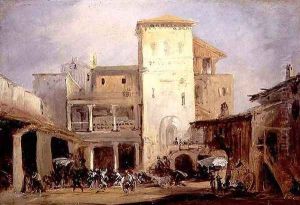Jenaro Perez Villaamil Paintings
Jenaro Pérez de Villaamil y d'Huguet, born on February 3, 1807, in Ferrol, Spain, was a pivotal figure in the Spanish romantic landscape painting tradition. His work is celebrated for its atmospheric portrayal of Spanish scenery, historic buildings, and monuments, infused with a romantic sensibility that captures the spirit of 19th-century Spain. Pérez Villaamil's artistic journey began in an era when Spain was undergoing significant social and political transformations, which influenced the thematic and stylistic direction of his work.
Pérez Villaamil's early life was marked by extensive travels, first due to his family's relocation to Madrid, and later through his own journeys across Europe. These travels played a crucial role in shaping his artistic vision, exposing him to various landscapes and architectural styles, as well as to the works of contemporary European artists. Despite the lack of formal art education in his initial years, Pérez Villaamil's innate talent and the skills he developed through self-study and observation were evident in his early works.
In the 1830s, Pérez Villaamil's career took a significant turn when he began to focus on landscape painting, a genre that allowed him to combine his love for travel and his passion for capturing the essence of Spain's diverse regions. His participation in the romantic movement, with its emphasis on emotion and nature, is evident in his atmospheric landscapes that often feature dramatic lighting and a sense of sublime vastness. One of his most notable contributions to Spanish art is his involvement in the publication of 'España artística y monumental' (Artistic and Monumental Spain), a series of lithographs that depicted Spain's architectural and natural wonders, showcasing his commitment to documenting and celebrating the country's heritage.
Pérez Villaamil's work received considerable acclaim during his lifetime, leading to his appointment as a court painter to Queen Isabella II of Spain. This position not only affirmed his status as one of Spain's leading artists but also provided him with opportunities to travel and paint across the country, further enriching his portfolio with diverse landscapes and architectural scenes. Despite his success, Pérez Villaamil's life was not without challenges, including financial difficulties and the struggle to secure consistent patronage, which were common issues faced by artists of his time.
Jenaro Pérez de Villaamil y d'Huguet passed away on June 5, 1854, in Madrid, leaving behind a rich legacy that has secured his place in the annals of Spanish art history. His works continue to be celebrated for their contribution to the romantic landscape genre and for their role in promoting the cultural and natural beauty of Spain to both national and international audiences. Pérez Villaamil's influence extends beyond his paintings, as his artistic vision and dedication to capturing the essence of Spain's landscape and heritage have inspired subsequent generations of artists and contributed to the preservation of Spanish cultural identity.




